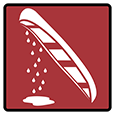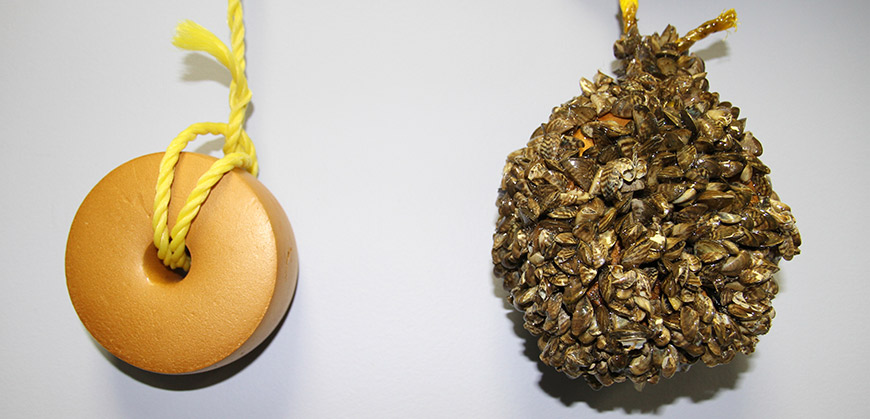
Aquatic invasive species
Prince Albert National Park
Aquatic invasive species (AIS) threaten freshwater ecosystems. Parks Canada needs your help to protect park waterways.
AIS are non-native plants, animals, invertebrates and diseases introduced to ecosystems either accidently or intentionally by human activity. AIS reproduce fast, rarely have natural predators and often out-compete native freshwater species. Once established, AIS are difficult, even impossible, to get rid of.
The spread of AIS can have serious consequences, including:
- Damage critical infrastructure.
- Impact lake, beach, and fishing visitor experiences.
- Alter aquatic ecosystems and biodiversity.
- Threaten already vulnerable species at risk.
Prevention is the most efficient and cost-effective way to manage AIS. Preventing the spread of AIS is a shared responsibility.
Help prevent the spread of aquatic invasive species
Clean Drain Dry your watercraft, trailer or water-related gear before and after each visit to Prince Albert National Park.

Clean and inspect your watercraft, trailer and all water-related gear.
- Rinse, scrub or wash your boat and gear.
- Clean on dry land, away from waterbodies, storm drains or ditches
- Wash and wipe off mud or sand because fish eggs or weed seeds can easily spread through mud
- Scrub and scrape grainy surfaces that feel like sandpaper because young invasive mussels are too small to see

Drain all water from your watercraft and water-related gear. Remove plugs in bilges, lower hulls, live wells and external ballasts tanks to drain any standing water.
- Fish eggs, diseases, young invasive mussels and spiny waterflea can be transported in standing water and are undetectable with the naked eye.
- Turn on bilge and ballast pumps to pump out water.
- Lower your motor to let water in the prop completely drain before raising for transport.

Dry all parts of your watercraft, trailer and water-related gear fully between trips to Prince Albert National Park.
- Many invasive species can survive in small amounts of water or moist conditions for a long time.
- Leave compartments open and gear out in the sun to fully dry before using again. Use paper towel, rags or a soft cloth to dry up residual water.
Pull the plug on your boat every time your watercraft moves between waterbodies.
Following Clean Drain Dry guidelines is the best way to prevent the spread of AIS in Prince Albert National Park.
Report aquatic invasive species sightings
Take a picture, note the location, and report it to Parks Canada immediately at:
iNaturalistPANP-PNPAiNaturalist@pc.gc.ca
Parks Canada Dispatch 1-877-852-3100.
Sightings outside of the national park can be reported online to the Saskatchewan Turn in Poachers and Polluters (TIPP) line or call
1-800-667-7561.

Rules and regulations
It is illegal to transport, possess or release AIS in Saskatchewan. Know the regulations before you visit:
- Federal Aquatic Invasive Species Regulations
- Saskatchewan Aquatic Invasive Species Prevention Program
Frequently asked questions
What aquatic invasive species are a concern?
AIS are non-native plants, animals, invertebrates and diseases introduced to ecosystems either accidently or intentionally by human activity. Below is a list of AIS of particular concern for Prince Albert National Park. View the full Saskatchewan AIS profiles.
Zebra and quagga mussels
Zebra and quagga mussels are small, fan-shaped, and range from dark brown to white in colour. A few mussels can produce millions of eggs. They are efficient at filtering nutrients from the water, leaving little to no food for native species. Dense colonies of mussels can plug drinking water and wastewater infrastructure and cover boat motors. They also can make shorelines unusable because of their sharp shells and odour. Invasive mussels are of highest concern. To date, there is no proven method for removing invasive mussels.
Whirling disease
Whirling disease is caused by a parasite. The parasite causes skeletal deformities of an infected fish’s body or head, usually in young fish, and the tail may appear dark or black. The disease can be spread to other waterbodies through spores in mud. This disease is not harmful to humans or other mammals but can have significant effects on salmonid fish populations, such as Lake Trout.
Eurasian watermilfoil
Eurasian watermilfoil is a perennial, submersed aquatic plant that grows in thick mats in shallow water areas like beaches. This creates undesirable swimming conditions. The mats also impact native fish species by reducing oxygen levels in the water and outcompeting native plants. New colonies can form from a single stem, seed or leaf.
Spiny water flea
Spiny water flea competes with native species for food and can lead to large declines in native zooplankton numbers. They are not a desirable food source due to their long tails and spines, allowing them to establish large populations.
Prussian carp
Prussian carp can reproduce by using sperm from other species of carp. Producing clones of the parent fish and disrupting reproductive rates of native fish. They out-compete native fish populations for food and habitat. Prussian carp impact irrigation and tourism by reducing water quality.
How are aquatic invasive species introduced?
AIS spread when people transfer mud, water, and live or dead organisms (such as plants, invertebrates and fish) between water bodies. Activities like boating, canoeing, kayaking, stand-up paddleboarding, and fishing can spread AIS.
Boats can spread microscopic invasive species, such as young zebra and quagga mussels, weed seeds, fish eggs, and diseases. These species survive in bilges, live wells, ballast tanks or bags and bait buckets and any gear that holds moisture, like life jackets and ropes. Invasive mussels can survive in moist areas for days and even weeks. Motorized watercrafts pose the highest risk due to their complex structures and operating systems. But all watercraft and water-related gear can carry AIS.
Detailed inspections may be necessary to remove all organic matter. Visitors can prevent the spread of AIS by following Clean Drain Dry best practices and adhering to regional and local requirements.
What watercrafts and water-related gear do I need to Clean Drain Dry?
To prevent AIS, it is important to Clean Drain Dry all watercraft and water-related gear before and after use, no matter where you are. This includes, but is not limited to:
- Motorized watercraft
- Canoes
- Fishing gear
- Kayaks
- Kiteboards and sails
- Paddles
- Rowboats
- Stand up paddle boards (SUP)
- Inflatables
- Inner tubes
- Lifejackets
- Rubber boots
- Waders and wading boots
- Wetsuits
- Sand pails and shovels
- Flippers and fins
- Masks and snorkel tubes
- Water shoes
- Anything that comes in contact with water
Is it necessary to Clean Drain Dry my watercraft, trailer or water-related gear if it is only being used within Prince Albert National Park?
Following Clean Drain Dry guidelines is the best way to prevent the spread of AIS, no matter where you are. Make Clean Drain Dry a habit before entering and after leaving any waterbodies. This includes before and after visiting Prince Albert National Park.
Have aquatic invasive species been found in Prince Albert National Park?
Currently, there is no evidence of AIS in Prince Albert National Park. But, AIS is spreading across Canada and is a threat.
Prussian carp has spread to Saskatchewan. Invasive mussels, spiny water flea, or whirling disease have not established in Saskatchewan. Zebra and quagga mussels are spreading quickly. They have spread in Ontario, Manitoba, Quebec in Canada and 34 US states . Whirling disease is present in Alberta and British Columbia.
What happens if AIS establish in a waterbody?
Invasive species are the second biggest threat to the planet's ecosystems, after habitat loss. The consequences of AIS include:
Reduced biodiversity and habitat quality:
AIS reduce the natural biodiversity and populations of native species, including species at risk. AIS prey on other species, compete for food or space or live on or in another organism. They also alter ecosystems and fish habitat, for example through eroding or destroying vegetation.
Increased costs and economic implications:
The presence of AIS cause substantial costs for aquatic industries and water infrastructure. For example, colonies of zebra and quagga mussels can block wastewater treatment plants, drinking water facilities and water lines to dams or power stations. It is costly to control, monitor and remove AIS after establishment. This results in decreased revenue to many industries, including tourism, water treatment and fisheries. Canada has spent billions of dollars to prevent, monitor and manage the impacts of invasive mussels since they arrived in the country in the 1980s.
Affected tourism and recreational opportunities:
AIS affects the tourism industry and visitor experiences. It impacts fishing, swimming, beaches and boating. AIS, like zebra mussels, attach themselves to tourism infrastructure, including marinas and docks. They push natives species out of recreational fishing areas and make water unsuitable for swimming. On the beach, mussel shells are sharp and can cut beachgoers' feet.
Prevention is the most efficient and cost-effective way to manage AIS.
What is Prince Albert National Park doing to prevent aquatic invasive species from entering the park?
Parks Canada works with the Government of Saskatchewan and other local water agencies to detect and prevent the spread of AIS. Prince Albert National Park conducts annual monitoring in many of its high-risk waterbodies to detect the presence of AIS. Parks Canada staff conduct water sampling for eDNA to detect larval zebra mussels, called veligers, and other AIS that could threaten park and neighbouring ecosystems. Staff also inspect docks, rope and buoys opportunistically at the end of each season.
A long-term AIS prevention strategy is in development for Prince Albert National Park.
Preventing the spread of aquatic invasive species is a shared responsibility. Following Clean Drain Dry guidelines is the best way to prevent the spread of AIS.
What are other national parks doing to prevent the introduction of aquatic invasive species?
To find out what other national parks are doing to manage AIS, please visit the following sites:
- Date modified :